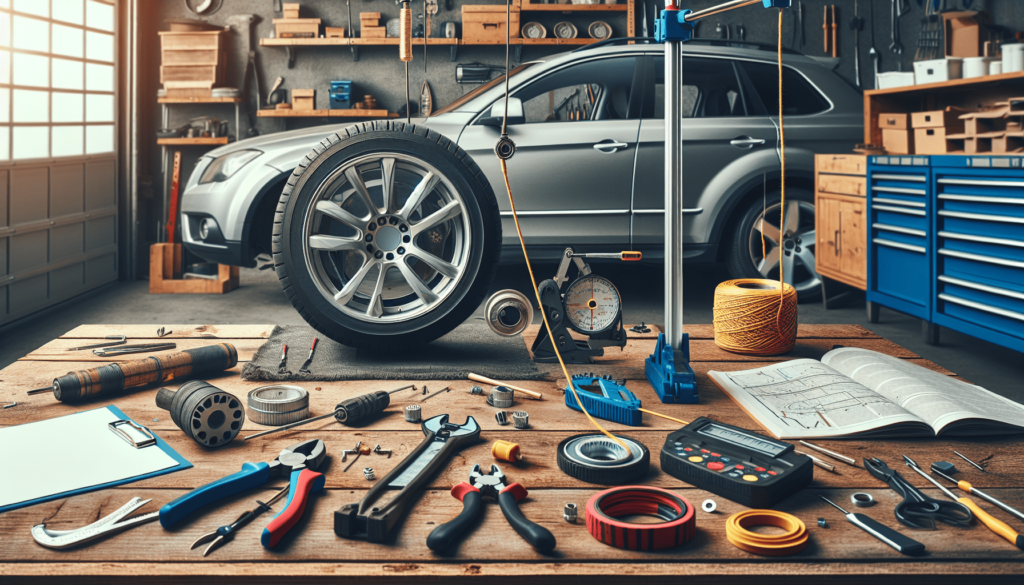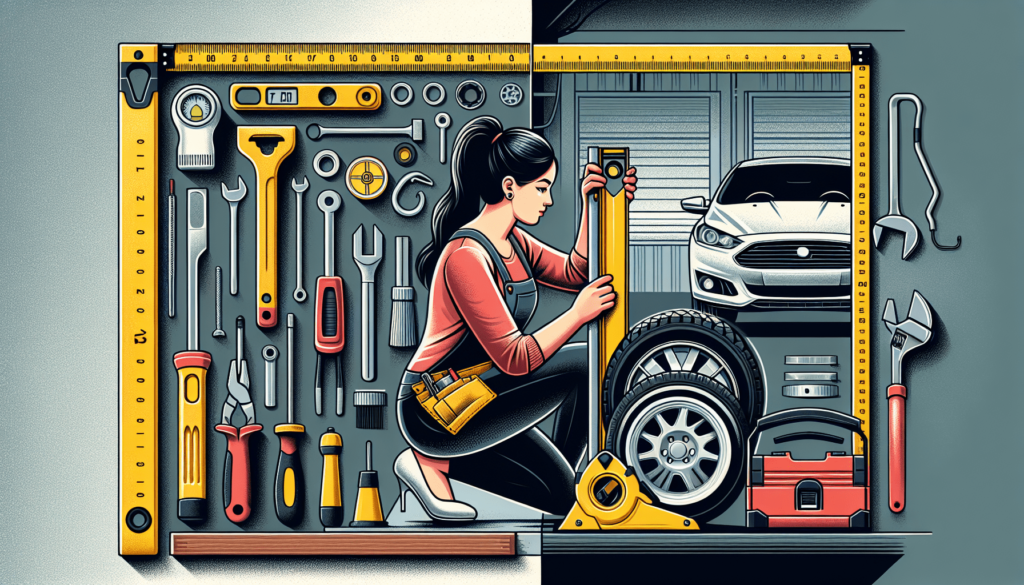If you’ve ever wondered whether you can align your wheels at home using DIY methods, this article has the answer for you. Many car owners find themselves facing this dilemma, wondering if professional alignment services are truly necessary or if they can tackle the task themselves. In this article, we’ll explore the feasibility of aligning your wheels at home, discussing the pros and cons, as well as sharing some tips to help you achieve optimal results. So, if you’re ready to dig deep into the world of DIY wheel alignment, let’s get started!

Understanding Wheel Alignment
Importance of wheel alignment
Proper wheel alignment is crucial for maintaining optimal driving performance and extending the lifespan of your tires. When your wheels are misaligned, it can lead to uneven tire wear, reduced fuel efficiency, and compromised handling and safety on the road. Ensuring that your wheels are aligned correctly is not only beneficial for your vehicle but also for your wallet, as it helps prevent unnecessary expenses on tire replacements and repairs.
What wheel alignment involves
Wheel alignment refers to the adjustment of the angles of the wheels to ensure that they are parallel to each other and perpendicular to the ground. It involves adjusting three key angles – camber, toe, and caster – to manufacturer specifications. Camber refers to the inward or outward tilt of the wheel, toe refers to the direction the wheels point, and caster refers to the forward or backward tilt of the steering axis. By aligning these angles correctly, you can achieve even tire wear, better traction, and improved steering response.
Symptoms of misaligned wheels
It’s important to be able to recognize the signs of misaligned wheels. Some common symptoms include uneven or rapid tire wear, excessive vibration or shaking while driving, pulling to one side while driving on a straight road, and a crooked or off-center steering wheel. If you experience any of these issues, it is likely that your wheels are misaligned and in need of adjustment.
DIY Methods for Wheel Alignment
Tools and equipment needed
Before attempting to align your wheels at home, you will need a few essential tools and equipment. These include a measuring tape or ruler, a set of jack stands, a pry bar, a wrench, and a camber gauge. It’s also important to have access to a flat and level surface where you can work on your vehicle.
Preparation and safety measures
Before getting started with the alignment process, it’s important to take some necessary precautions and ensure your safety. Make sure your vehicle is parked on a flat surface and set the parking brake to prevent any unwanted movement. Place the jack stands securely under the vehicle to provide stability, and always wear protective gloves and eyewear when working on your car.
Step-by-step alignment process
To begin the alignment process, start by measuring the current camber angle of each wheel using a camber gauge. This will help you determine if any adjustments are necessary. If adjustments are needed, use a pry bar and wrench to loosen the bolts on the control arms and carefully adjust the tilt of the wheels to achieve the desired camber angle. Repeat this process for each wheel.
Next, move on to adjusting the toe angle. Measure the current toe angle using a measuring tape or ruler, and mark the position of each tire. Loosen the tie rod ends and adjust the length to achieve the desired toe angle. Make sure to tighten the tie rod ends and double-check the alignment before moving on to the next wheel.
Lastly, evaluate the caster angle by visually inspecting the steering wheel position. If the steering wheel is not centered, adjust the caster angle by loosening the bolts on the strut mounts and carefully repositioning the strut assembly. Once the adjustments are made, tighten the bolts securely.
Assessing Wheel Alignment
Visual inspection
Performing a visual inspection of your vehicle’s wheels is a quick and easy way to assess the alignment. Look for any signs of uneven tire wear, such as excessive wear on the inner or outer edges of the tires. Inspect the tires for any bulges or abnormalities, as these can also indicate misalignment. Additionally, visually inspect the steering wheel position to see if it is centered or crooked.
Measuring tire wear patterns
Another method for assessing wheel alignment is by examining the tire wear patterns. Uneven wear patterns can provide valuable insights into the alignment of your wheels. For example, excessive wear on one side of the tire suggests an alignment issue, such as improper camber or toe angles. Be sure to inspect all four tires and take note of any irregular wear patterns.
Checking steering wheel position
An off-center or crooked steering wheel is another indication of misaligned wheels. While driving on a straight road, observe the position of the steering wheel. If it does not sit perfectly centered, it is likely that there is a misalignment that needs to be addressed. Checking the steering wheel position can serve as a quick diagnostic method before moving on to more extensive alignment adjustments.
Adjusting Camber Angle
Understanding camber angle
Camber angle refers to the vertical tilt of the wheels when viewed from the front or rear of the vehicle. A negative camber angle indicates that the top of the wheel is tilted inward, while a positive camber angle means the top of the wheel is tilted outward. It is important to have the camber angle set correctly to ensure even tire wear and proper handling.
Determining if adjustment is needed
To determine if camber angle adjustment is necessary, measure the current camber angle using a camber gauge. Compare the measured angle to the manufacturer’s specifications for your vehicle. If the measured angle is outside of the recommended range, adjustments are needed.
Methods to adjust camber angle
Adjusting the camber angle can be done by loosening the bolts on the control arms or strut mounts and carefully adjusting the position of the wheels. However, it is important to note that not all vehicles have adjustable camber angles. Some vehicles have fixed camber angles, in which case professional assistance may be required to correct any misalignments.

Setting Toe Angle
Explaining toe angle
Toe angle refers to the direction in which the wheels point in relation to the vehicle’s centerline when viewed from above. Positive toe angle means the front edges of the tires are pointing towards each other, while negative toe angle means the front edges are pointing away from each other. Proper toe angle is important for maintaining straight-line stability and reducing tire wear.
Determining if adjustment is necessary
To check if toe angle adjustment is needed, measure the current toe angle using a measuring tape or ruler. Evaluate the distance between the front and rear of the tires and compare it to the manufacturer’s recommended specifications. If the measured toe angle is outside of the specified range, adjustments are necessary.
Techniques to adjust toe angle
Adjusting the toe angle can be done by loosening the tie rod ends and adjusting the length to bring the wheels into the correct alignment. It is crucial to make equal adjustments to both sides to maintain balanced alignment. Once adjusted, tighten the tie rod ends and double-check the alignment before moving on to the next wheel.
Aligning Caster Angle
What is caster angle?
Caster angle refers to the forward or backward tilt of the steering axis when viewed from the side of the vehicle. It plays a significant role in stability, steering effort, and returnability. A positive caster angle enhances straight-line stability, while a negative caster angle can result in reduced stability and steering control.
Evaluating caster angle
Caster angle can be visually evaluated by inspecting the steering wheel position while driving on a straight road. If the steering wheel is off-center or exhibits a slight pull to one side, it suggests that the caster angle needs adjustment. Additionally, a precise measurement of the caster angle can be done using specialized equipment in professional workshops.
Methods to correct caster angle
Correcting the caster angle can be achieved by loosening the bolts on the strut mounts and carefully repositioning the strut assembly to the desired angle. It is important to note that adjusting the caster angle may require more advanced tools and expertise beyond the capabilities of DIY methods. If you suspect a caster angle issue, it is recommended to consult a professional for accurate adjustments.

Testing Wheel Alignment
Performing a test drive
After completing the alignment adjustments, it is essential to perform a test drive to assess the effectiveness of your DIY wheel alignment. Take the vehicle for a drive on a variety of road conditions, including straight stretches and curves, and pay attention to how the vehicle handles.
Evaluating vehicle handling
During the test drive, observe the vehicle’s handling characteristics. Check if the vehicle tracks straight on a level road without any pulling to one side. Take note of any vibrations, steering wheel drift, or unusual noises that could indicate remaining alignment issues.
Fine-tuning alignment if necessary
If you notice any lingering alignment problems during the test drive, it may be necessary to fine-tune the alignment. Reassess the camber, toe, and caster angles, and make necessary adjustments as per the previously mentioned techniques. It may take several iterations to achieve precise alignment, so remain patient and persistent when fine-tuning.
Limitations and Considerations
Accuracy of DIY methods
While DIY wheel alignment can be a cost-effective solution, it is important to acknowledge its limitations. DIY methods may not provide the same level of accuracy and precision as professional alignment services. Modern vehicles often have complex suspension systems that require specialized equipment and expertise to achieve optimal alignment.
Complexity of modern suspensions
Modern suspensions incorporate intricate components and advanced technologies, making alignment more challenging for DIY enthusiasts. Electronic steering systems, adaptive suspensions, and other advanced features may require specific diagnostic tools and software to properly align the wheels. As a result, it is crucial to recognize the limitations of DIY methods and seek professional assistance when needed.
Specialized equipment and expertise
Professional alignment shops have access to specialized equipment, such as laser alignment systems, that allow for highly accurate measurements and adjustments. In addition to the equipment, professional technicians possess the knowledge and experience to diagnose complex alignment issues and make precise adjustments. If you lack the necessary tools or expertise, it is advisable to consult a professional for wheel alignment services.

When to Consult a Professional
Safety concerns and risks
If you are uncertain about your ability to perform a proper wheel alignment or lack confidence in your DIY skills, it is best to consult a professional. Wheel alignment is a critical aspect of safe driving, and improper alignment can lead to hazardous situations on the road. Putting your safety and the safety of others at risk is not worth the potential cost savings of a DIY approach.
Persistent alignment issues
If you have attempted DIY wheel alignment and continue to experience alignment problems or unusual tire wear despite your efforts, it is important to consult a professional. Persistent alignment issues may indicate underlying mechanical problems or issues that require specialized knowledge and equipment to diagnose and resolve effectively.
Specialized alignment requirements
Certain vehicles, such as high-performance or specialty vehicles, may have unique alignment requirements that go beyond the capabilities of DIY methods. These vehicles often require specific alignment procedures or equipment that only professionals have access to. To ensure precise and accurate alignment, it is recommended to rely on professional services for these vehicles.
Conclusion
DIY wheel alignment can be a feasible option for some individuals, especially those with basic knowledge and skills. By understanding the importance of wheel alignment, familiarizing yourself with the necessary tools and techniques, and following proper safety measures, you can attempt to align your wheels at home. However, it’s important to acknowledge the limitations of DIY methods, the complexity of modern suspensions, and the specialized expertise and equipment that professional alignment services provide. When in doubt or facing persistent issues, it is wise to consult a professional for accurate and reliable wheel alignment that ensures optimal vehicle performance and safety on the road.


